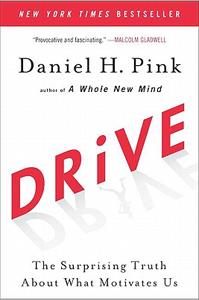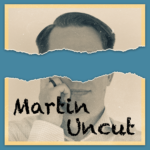Drive was a book that I started to read a long time ago. But for whatever reason I got sidetracked and it got left untouched on my bedside table. I did not give the book a real chance. A few days ago I thought I should. This time around I read it carefully and with intent to learn and understand.
Drive is a book that investigates motivation by looking at what was the motivational factors in the past and what the main drivers are in the current society of knowledge workers. Pink wants to show the differences in how organisations and families motivates and what science has learnt. He does that by structuring the book in three sections.

In the first section the scene is set. We learn about the different types of motivations and we get to know about the analogy to a computer operating system. Operating systems are evolving and new releases comes out to fix issues and bugs in the software. Motivation can be seen in the same way. In the beginning, in Motivation 1.0, motivation came from the drive to survive and reproduce. But as civilisation formed and developed, a new version, a version that increased productivity and growth, was uncovered. This was Motivation 2.0. You may know it as “the carrot and the stick”. Desired behaviours are rewarded and undesired behaviours are punished. Like donkeys the workforce is coerced into complying by blindly following the treat while avoiding the lash on the back. This is still the main tool for driving and motivating employees today.
But something happened. These type of motivational strategies doesn’t seem to work as well anymore. Sometimes they also give the opposite effect providing negative impact on morale, motivation and performance. New parameters have become more important as the basic needs has been fulfilled. This is what Pink calls Motivation 3.0. The new operating system that we need to start installing into our organisations and life. In the previous versions motivation was driven by external factors such as money and fame. It is extrinsic motivation. The new version is driven from the inside. It is intrinsically generated. It can still be influenced by external factors, both in a positive and negative way. But it cannot be given.
A personal reflection; as people grow and more of the levels in Maslow’s hierarchy of needs are reached, different parameters becomes important for motivation. Basic needs can be fulfilled by Motivation 1.0. As the psychological needs starts to be fulfilled motivation 2.0 kicks in. When at the very top of the pyramid the intrinsic motivation, Motivation 3.0, will becomes more dominant as a motivational factor.
But let us get back to the book. In the second section Pink describes the three new parameters that impacts the intrinsic motivation. The first is autonomy. The drive to have control over your life. The wish to be self-directed. This can be broken down in four subcategories. The autonomy of task, time, technique and team. Essentially this means what you do, when you do it, how you do it and with whom you do it. The ability to control or impact these are important factors when motivation is considered.
The second parameter is mastery. The drive to become better and better. In this section Pink also discusses the importance of flow. To be totally engulfed in a task so that space and time gets blurred. To regularly achieve a flow-like state is important for mental well-being. Related to this is the process of deliberate practice. A process where you continuously strive to improve by continuous practice. The goal is the learning and the mastery of the task. With this mindset failures becomes less dangerous since a failure would mean, in most cases, a learning. A failure with the old, extrinsic, motivation would have been seen as a lack of ability and a risk for negative consequence (stick). This could lead to unethical or other unexpected behaviours.
The third and final parameter is purpose. It is important to feel control over your life. That we get with autonomy. We also want to feel that what we do have meaning and purpose. The importance of purpose has already started to manifest it self in how companies are being operated. Increased focus on Corporate Social Responsibility, CSR, a term used heavily in both brand marketing with focus on employees and company. New types of companies, with new operating models, are started. With focus to maximize purpose, instead of profit. The profit is still important but becomes an enabler to full fill the purpose. Not the goal.
The third and final section of the book is a toolkit with the intention to help you implement behaviours and techniques to fuel intrinsic motivation. This can be used both as an individual, a parent or a manager. Everyone will be able utilize these tools. This section is something you can read individually without having to read the whole book. It will still provide a value to you as a reader. A nice twist is that there is a short chapter summarising the entire book.
In the book Pink’s goal is to show the differences to what individuals and companies do to drive and motivate people and what the science has learned. The book fulfils this goal very well but I believe the picture about the current state is more grim then what it is in reality. I find a lot of these things obvious and as expected behaviours in strategies today. For most of us we inherently know that autonomy, mastery and purpose are important things that can be motivational. But in this book I got a better understanding to why this is the case. I was neither aware of the danger of using the carrot and stick approach in a situation where intrinsic motivation is important. Most modern companies, at least in Sweden, are already working with these strategies in different ways to create an attractive workplace. The competition over the right people is so high and with the monetary, carrot, approach to find and keep people loosing its edge; new ways needs to be discovered. But in less competitive environments Pinks gloom description of the old use of motivational methods could very well be true in Sweden too.
Over all a very good book that provides a good deal of thought. I can highly recommend it.
If you prefer to listen, instead of reading, you can listen to Martin Uncut, Ep# 83 – April 30 – Drive by Daniel Pink. You can also find it in the player below.





